Still Leading the Way: Manufacturers Make Creators Wanted Live Possible
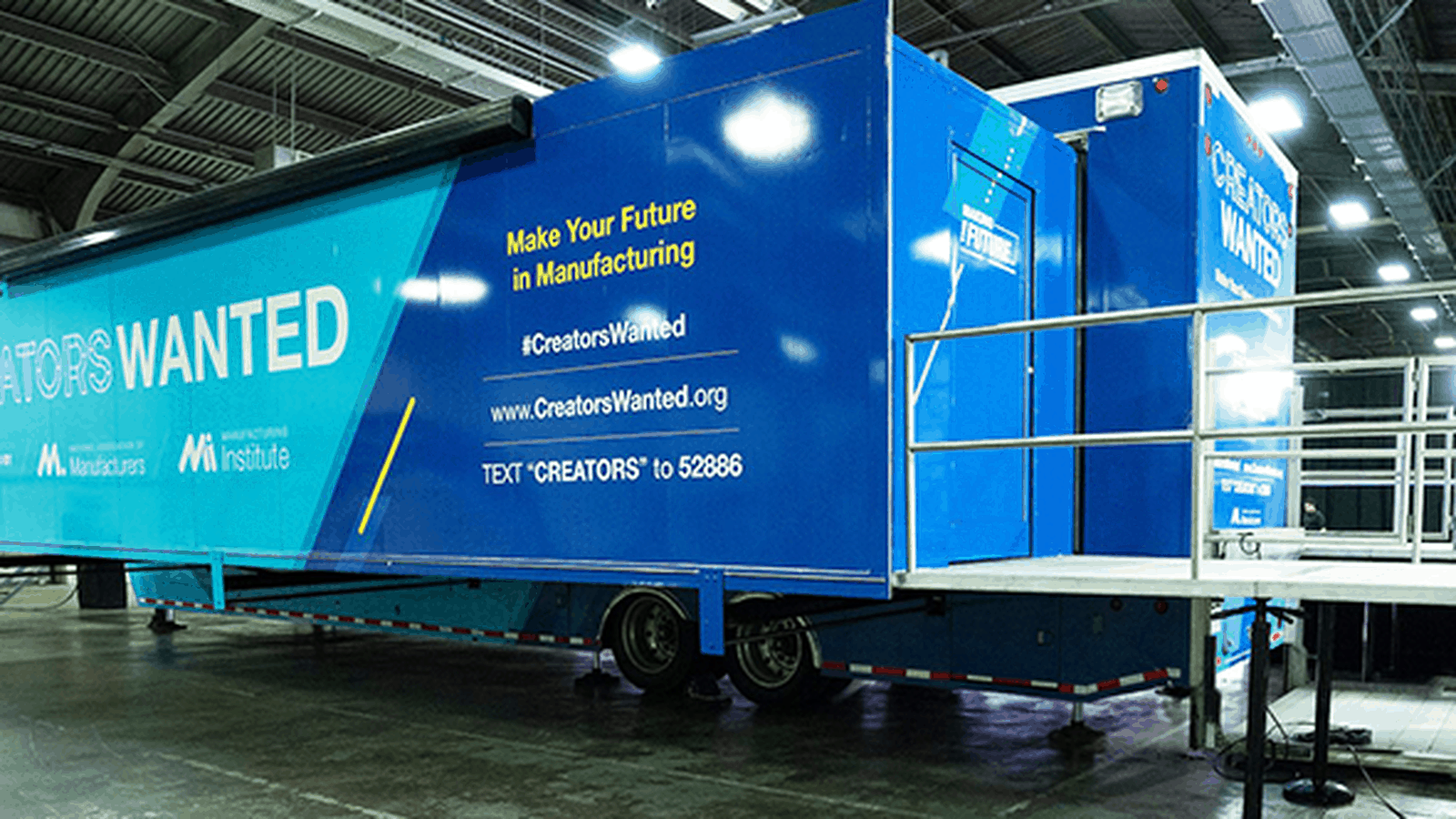
Through a global pandemic, manufacturers have led the way on health and safety measures, helping keep Americans working—for the U.S. and the world. Now the manufacturing industry continues that leadership while recruiting and inspiring the creators of the future.
On the road: Creators Wanted, the workforce campaign of the NAM and the MI, is getting ready to hit the road. The campaign formalized its COVID-19 safety protocols and is employing state-of-the-art technologies, like Sphere Synexis, provided by legacy sponsor Trane Technologies, to continuously fight viruses, bacteria and other hazards in the air and on surfaces. The mobile experience, along with other programming events and new online resources, will bring the story of modern manufacturing to communities across the country.
- The experience, recently endorsed by The Dallas Morning News, is designed to capture the imaginations of students, teachers and parents and inspire the next generation of manufacturers.
- It will complement the upcoming release of the NAM and MI’s innovative online resources for those seeking a career in manufacturing.
Coming to a town near you: The NAM and MI released the following Creators Wanted Live tour dates and stops.
- Oct. 4–7: Columbus, Ohio
- Oct. 12–15: Charlotte, North Carolina
- Oct. 20–22: West Columbia, South Carolina
- Nov. 8–10: Pella, Iowa
- Nov. 16–18: Freeport, Texas
- Nov. 30 – Dec. 3: Dallas, Texas
Wait, there’s more! Community programming stops are also coming to Detroit, Michigan; Guthrie, Kentucky; Pittsburgh, Pennsylvania; and Carson City, Nevada. And a new suite of digital and online experiences and tools will bring the campaign to every state.
Thanks to strong support: “Our ability to mount this bold solution to the workforce crisis through the difficulties of a pandemic has been anything but certain,” NAM President and CEO Jay Timmons and NAM Board Chair Mike Lamach said in a joint message to NAM membership. “It has taken the unwavering and strong support of some of America’s leading enterprises and business leaders to keep this campaign alive.”
See the full list of Creators Wanted sponsors here. Want to support the effort? Get involved—at any price point—here.
From a Small Farm to a Global Manufacturing Company: A STEP Honoree Story

Neha Phadke is a long way from home. Originally from a small farming village in India, Phadke grew sugar cane, onions, wheat and watermelon to support her seven-person family while she completed her bachelor’s degree. She moved to the United States to earn her Ph.D. in organic chemistry when Texas Tech University offered her full funding.
Today, Phadke works as a senior process chemist at Covestro, a high-tech polymer materials manufacturer that makes products used in industries including automotive, construction, health care, cosmetics, energy, electronics and sports. It’s her responsibility to find ways to improve production while maintaining quality.
Focused on manufacturing: Even when she was studying organic chemistry as an undergraduate and grad student, Phadke knew that she was more interested in applied science than academia. Near the end of her Ph.D. program in 2015, she received an internship opportunity at Covestro, which was then called Bayer Material Science. That internship turned into a job offer, and she has been working at Covestro ever since.
- “I was asked if I wanted to go into research and academia or manufacturing, and I was 100% sure I wanted to go into manufacturing,” said Phadke. “I had a feeling that this was where I belonged.”
Everything’s bigger in Texas: Still, Phadke faced a learning curve when she shifted from academia to manufacturing, including the scale of the work she was doing.
- “I had never seen big plants and reactors,” said Phadke. “I had worked on my Ph.D. in milligrams, and here I’m making more than 30,000 pounds of material in the reactors. It was fascinating, and I enjoyed the experience, process and learning through the new challenges.”
Standing up: Phadke may work in an environment that’s traditionally been male dominated, but she has never let that stop her before. Even when she was growing up, she knew that her ability to succeed should have nothing to do with her gender.
- “I was always asked if I had a sibling, and I would say I have a younger sister—and I would get sympathy for not having a brother,” said Phadke. “As a kid, I wouldn’t understand why it should make any difference. And it pushed me to think: why can’t I do anything a guy can do?”
Serving as an example: The Manufacturing Institute recently selected Phadke as a 2021 STEP Ahead Award Honoree—an honor given to women leaders who have excelled both within their companies and in the industry as a whole. She encourages other women to get involved in manufacturing and says that, while the industry might seem daunting, she’s gotten plenty of support from her colleagues and her company.
The last word: “Anything is possible,” said Phadke. “Don’t let anyone stop you from doing what you believe is right. Wear your courage, face your fears, lead your path, follow your passion and inspire others.”
Learn more about the STEP Ahead program, including how to honor remarkable women on your team, here.
Manufacturers’ Job Training Gets a Federal Boost
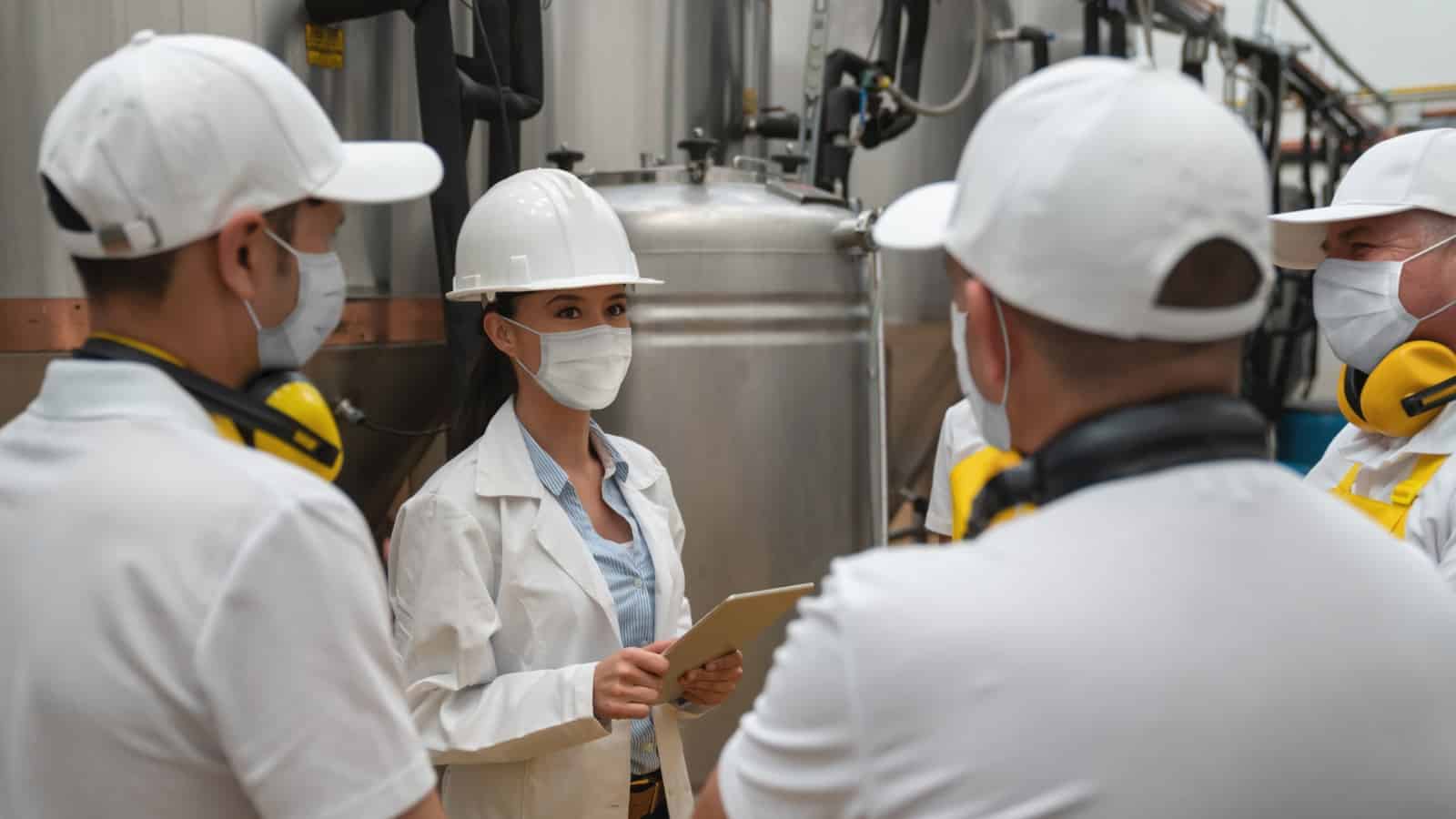
The Economic Development Administration has $3 billion to spend on job training—and manufacturers should start preparing now to attract some of that funding to their regions.
What’s happening: The American Rescue Plan Act, signed into law by President Biden in March, set aside $3 billion for a historic investment by the EDA in bottom-up economic development, according to a recent information session hosted by The Manufacturing Institute, the workforce development and education partner of the NAM.
- Part of that money includes $500 million for the EDA’s Good Jobs Challenge, which helps fund job-training programs from design and development through implementation.
Applicants wanted: Applications for the funding—which can be spent by eligible recipients on a wide variety of expenses, including curriculum development, equipment purchases and training-facility leases—are due Jan. 26, 2022. (Read the Notice of Funding Opportunity here.)
“One of the key things we’re looking for in these proposals is a commitment to hire,” said EDA Deputy Assistant Secretary for Policy Michele Chang. “We are in a time where we want to get folks back into jobs quickly.”
Who’s eligible? While nearly all types of public and private nonprofit groups are eligible, the EDA is seeking organizations that have strong credibility with employers and a proven track record of success.
- How manufacturers can help: Raise this grant opportunity with your trusted economic development or workforce partner and encourage them to contact the MI at [email protected] to learn more.
- A good fit: The EDA program is a natural fit for the MI’s efforts, according to MI Vice President of Strategic Initiatives Gardner Carrick. As he put it, “We are all working to attract more individuals to manufacturing.”
Boot Camp: Those who want to put their best foot forward during the EDA application process should consider the MI Boot Camp. These eight coaching sessions, which will run from mid-September to mid-December, will include workshops, discussions and expert mentorship designed to help applicants compete for the funds.
- The MI Boot Camp is provided free of charge, but attendees will be selected via an application process. Email [email protected] for more information and how to apply.
Why it matters: Manufacturers are dealing with a worrying lack of skilled workers. As of July, the industry had a total of 889,000 job openings, according to the Bureau of Labor Statistics. This vacuum could grow to 2.1 million unfilled jobs by 2030, according to a recent study by Deloitte and the MI—an excellent reason to expand training programs as fast as possible.
The last word: The MI encourages all those who meet eligibility requirements to apply for funds to support their job-training programs. Said Carrick: “The EDA has to be commended for what is really a very impressive grant program.”
Interested in more of the NAM and MI’s work to attract workers to the manufacturing industry? Check out our Creators Wanted campaign.
FAME Program Grows Despite the Pandemic
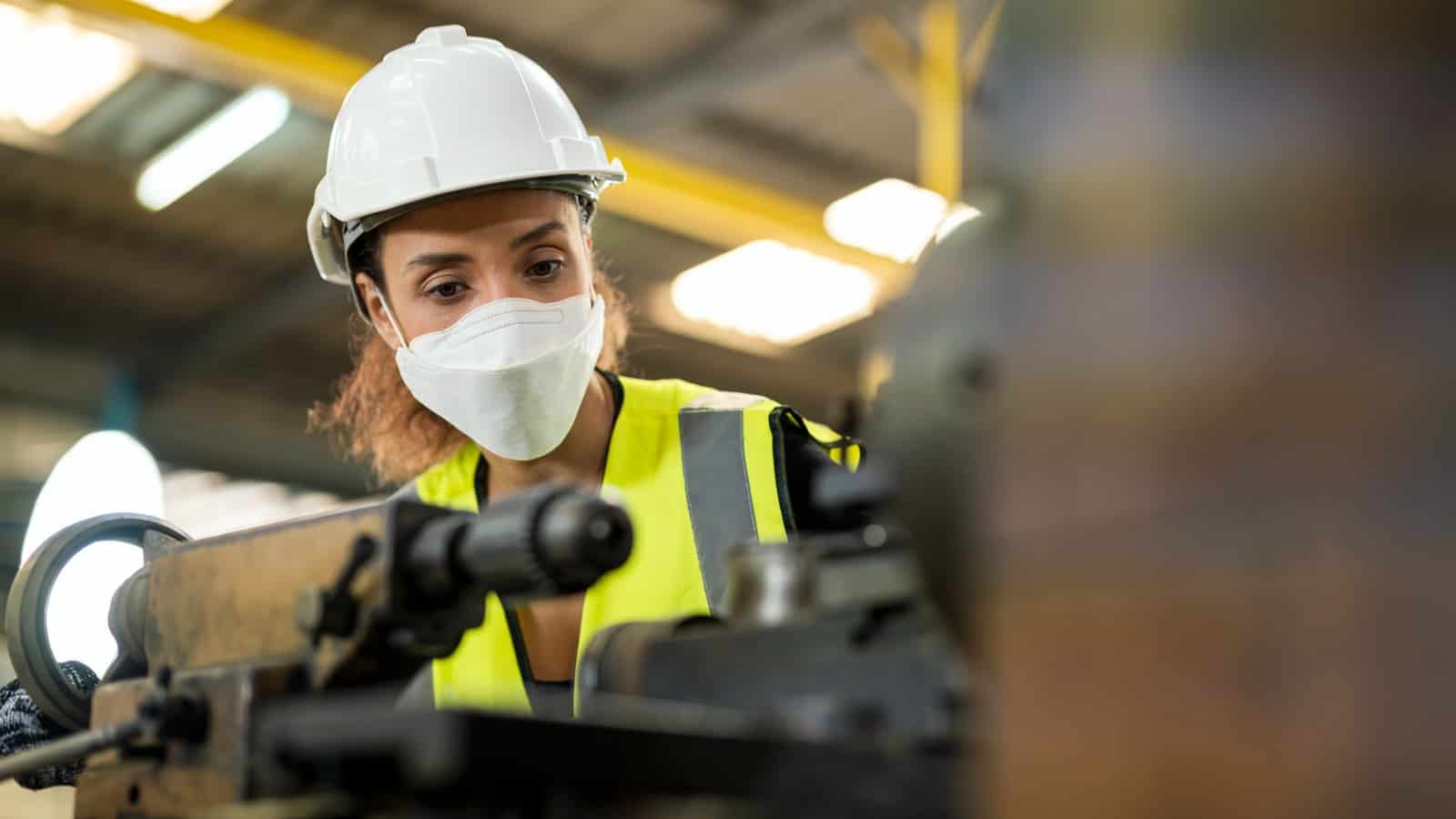
The past 18 months have been trying for students of all ages, as they have navigated virtual learning in place of or in combination with in-person classes. But for many of those enrolled in the Federation for Advanced Manufacturing Education (FAME) program, 2020 and 2021 have presented a unique educational and professional opportunity.
The background: Founded by Toyota and now operated by The Manufacturing Institute, FAME is the top U.S. program for training students who seek careers in manufacturing. Enrollees who complete it earn associate degrees and certification as advanced manufacturing technicians (AMTs), while working part time in manufacturing facilities—and being paid competitively.
- “After two years of increasing experience, consistent organizational and cultural acclimation, as well as professional growth—coupled with the company’s investment made in wages—most graduating AMTs (about 85%) go to work for the sponsoring employer upon graduation,” MI Workforce Initiatives Senior Director Tony Davis told us.
The first pandemic opening: Despite the global outbreak of COVID-19 less than six months prior, FAME saw the opening of a new chapter in fall 2020: FAME on the Plains, based in Opelika, Alabama.
- “It was a challenge, to say the least,” says Davis. “But they recruited about nine students.” Three will graduate in May 2022, having overcome some unprecedented challenges.
- In fact, the chapter remained undaunted and, thanks to the appeal of the earn-and-learn FAME model, is heading into fall 2021 with 25 AMT students.
Nine more chapters, coming soon: That one chapter was only the beginning. Thanks to its successful virtual recruitment efforts and other outreach, FAME will open nine new chapters in 2021. This explosive growth—nearly 40% since last year—brings the number of national FAME chapters to 32 across 12 states. Here are the new chapters by state:
- Colorado: Colorado will get its first FAME chapter, CO FAME of Pueblo.
- Florida: Florida, also a first timer, will get not one but two new chapters: the FL FAME – Gulf Coast Chapter of Bay County/Panama City and the FL FAME – Sunshine Chapter of Volusia County/Daytona Beach.
- Indiana: Indiana will acquire chapters two, three and four in the state: the Central, Hoosier and NEI chapters, which are located respectively in Indianapolis, Anderson and Fort Wayne. These chapters join the IN FAME – So.INFAME Chapter of Vincennes.
- Michigan: Michigan will also get a new entry on the FAME map, thanks to the MI FAME – JAMA Chapter of Jackson.
- Texas: Texas will get its second location, the TX FAME – Dallas Chapter of Garland.
- Virginia: And last, Virginia is also starting its first chapter, the VA FAME – Central Virginia Chapter of Prince George County/Petersburg.
The last word: “We are proud to welcome so many new locations into the FAME network,” said MI Vice President of Strategic Initiatives Gardner Carrick. “It is a testament to the seriousness of the workforce shortage and the success of the FAME model that companies have been willing to invest in this solution during this challenging year. We’re excited to support these new companies and look forward to welcoming hundreds of new FAME students this fall.”
Timmons on the Passing of Labor Leader Richard Trumka
Washington, D.C. – National Association of Manufacturers President and CEO Jay Timmons released the following statement on the passing of AFL-CIO President Richard L. Trumka.
“America has lost a tremendous leader with the sudden passing of Richard Trumka. I was privileged to call him a friend and colleague, working with him closely on issues ranging from infrastructure and workforce development to protecting civil rights and advancing equality. Like so many others, I learned a great deal from him along the way and admired his unshakeable authenticity and decency.
“He was a patriot and a statesman who demonstrated unwavering strength of purpose and never forgot who he represented. We may have sparred at times on policy priorities, but one thing was always clear: whether we aligned on an issue or took differing views, he was fighting with conviction on behalf of American workers and for a stronger America.
“Perhaps most of all, I appreciated his belief that management and workers have far more that unites them than divides them. He shared a commitment to the preservation and expansion of democracy here and around the world. He understood that our economy’s success and workers’ future depend on faith in our institutions. His powerful words in response to the January 6 insurrection are stamped in history and exemplified his resolve to stand strong against forces that would undermine our constitutional democracy.
“We extend our deepest condolences to his wife Barb, his family and to his AFL-CIO colleagues. His vision, voice and leadership will be greatly missed, but America is truly blessed to have had his countless contributions.”
-NAM-
The National Association of Manufacturers is the largest manufacturing association in the United States, representing small and large manufacturers in every industrial sector and in all 50 states. Manufacturing employs more than 12.3 million men and women, contributes $2.35 trillion to the U.S. economy annually and has the largest economic multiplier of any major sector and accounts for 63% of private-sector research and development. The NAM is the powerful voice of the manufacturing community and the leading advocate for a policy agenda that helps manufacturers compete in the global economy and create jobs across the United States. For more information about the NAM or to follow us on Twitter and Facebook, please visit www.nam.org.
Get Ready for MFG Day 2021!

We’re just two months away from MFG Day 2021! If you’re a manufacturer and you haven’t done so already, it’s time to start thinking about hosting an event.
Amplifying the “Creators Wanted” message, MFG Day—which officially falls on October 1 but will be celebrated throughout the rest of the month—is manufacturing’s biggest celebration of the year, a chance for parents, students and educators to step inside the industry and see everything it has to offer. It’s nothing less than our biggest annual opportunity to “solve the workforce–development crisis,” as MI Senior Director of Student Engagement Julia Asoni put it during a recent webinar.
Here’s what you need to know.
The crisis: Manufacturers will need to hire 4 million workers between now and 2030 to account for growth and fill positions left open by retiring workers, according to a recent study by Deloitte and the MI. Yet 2.1 million of those jobs could go unfilled because of the skills gap.
- “The solution is to inspire the next generation of manufacturers and educate students, parents, teachers and the public on the important role that manufacturers play in our lives,” Asoni said.
Making a difference: In 2019, more than 325,000 MFG Day participants took part in 3,000 events across North America, Asoni noted. Afterward, 72% said they now believed “manufacturing provides an interesting and rewarding career.”
- MFG Day 2020 moved online due to the pandemic, but this year, it’s back in force and in person.
What can you do? Manufacturers that wish to host an event this MFG Day but don’t know where to start have come to the right place.
- In-person options: Facility tours, open houses, community gatherings and expos, roundtable discussions and job fairs all make excellent events, Asoni said.
- Go virtual: Virtual events can be successful, too. Consider Zoom, GoTo Meeting, Instagram Live, Facebook or a specific school platform (if working in partnership with a school). Interested in hosting a 3D-mapped, virtual experience for MFG Day? Contact NAM AVP of Strategic Partnerships Chris Schmitt at [email protected].
- “What will participants do?” Engaging working employees during onsite tours is crucial, Asoni said. “Personal experience has the greatest impact on perception change, according to research.” So get creative when thinking through your visits and walk-throughs!
- “Whom do we invite?” Reach out to local schools and community-based organizations, such as nearby Boys & Girls Clubs of America. BGCA can be contacted for partnership purposes at [email protected].
- Learn more about MFG Day through our full page of MFG Day resources. And listen to prior best practices shared by MFG Day hosts on a webinar hosted last month.
Register your event: Be sure to register your MFG Day events by the end of August. This will help people find them and sign up.
Calls to action: MFG Day event hosts should each have their own calls to action—steps that attendees can take to keep engaging with manufacturing. This could be signing up for a company newsletter, following the company on social-media channels or attending another event, such as a career day.
- This year, we’re launching a built-in call to action to engage students year-round. Stay tuned for more information in September!
Check it out: As MFG Day nears, keep checking in on CreatorsWanted.org. It will be updated and refreshed continually up to Oct. 1 with new MFG Day resources, along with updates on the broader Creators Wanted campaign to help inspire, educate and empower the next generation of manufacturing talent.
More support: Need a bit more help? Join us for some real-time Q&A during one of our upcoming MFG Day Office Hours.
To the Moon and Then Mars: An Interview with a STEP Honoree

Jennifer Boland-Masterson originally got excited about manufacturing because of the robots. The Indiana native later graduated from Purdue University with a degree in electrical engineering, then worked in the automotive and boat industries before joining Boeing. Today, she is Boeing’s director of operations, Space Launch System, and leads the team that is building NASA’s SLS rocket—the most powerful rocket in development today.
“The plan is to get us back to the moon, and then to Mars, and this rocket has the payload to make it happen,” says Boland-Masterson. “We’re building the next generation of the space program, and that’s my day-to-day.”
A manufacturing advocate: Boland-Masterson was recently selected by The Manufacturing Institute as a 2021 STEP Ahead Award Honoree—an honor given to women leaders who have excelled both within their companies and in the industry as a whole. She sees sharing stories as an important way of encouraging other young women to go into manufacturing and frequently attends science, technology, engineering and math events in her community to demystify the industry for young people and their parents.
- “The earlier that girls and their parents understand that STEM events are not just for boys, and [the earlier] they see role models in the fields they aspire to be in, the better,” says Boland-Masterson. “It gives them that energy. They realize, hey, I can do that too.”

- “It might look male-dominated, but the dynamics are changing,” she adds. “You’re seeing more diversity in these engineering, tech, science areas. It’s exciting to see that change.”
It takes a village—and some confidence: Boland-Masterson emphasizes the importance of teamwork and of being able to build a community among your friends and colleagues.
- “Make sure you have a good support system,” she advises young people. “We can’t do it by ourselves. We have to have people we can ask for advice or help. Whether you’re a woman or a man, everyone needs that support system.”
- “We all will have challenges, but that’s okay,” she adds. “You’re your number one fan, and when you believe in yourself, you can accomplish anything and everything you want.”
An unexpected journey: Even as someone who hoped to go into manufacturing from an early age, Boland-Masterson was surprised by the range of opportunities she encountered in the industry. Her work has turned out to be both international and interplanetary.
- “I would never have imagined as a kid that I would be building a rocket that will carry astronauts into deep space,” says Boland-Masterson. “I would never have guessed. Growing up in Indiana, I thought I would stay in Indiana my whole life. But getting into manufacturing, I’ve had an opportunity to go across the country and around the world.”
And does she work with robots?: “Believe it or not, I don’t work with any robots,” Boland-Masterson says, laughing. “My day-to-day is all about human interaction. But I say keep an open mind and that will take you to wonderful, unexpected places.”
Creators Wanted Gets an Endorsement

The NAM and The Manufacturing Institute’s Creators Wanted campaign got a resounding endorsement from The Dallas Morning News, which called the initiative “a smart approach that may be a harbinger of things to come” in a recent editorial (subscription).
Traveling attraction: “‘Creators Wanted’ . . . will visit schools and community gathering places around the country in coming months to attract future workers to that industry. Creators Wanted features a tractor-trailer-mounted escape room and ‘immersive experience’ designed to hold kids’ attention while also overcoming stereotypes that keep students from choosing careers in manufacturing.”
Filling a void: As the editorial notes, Creators Wanted “aims to reduce the skills gap in the U.S. by 600,000 workers by 2025, and increase the number of students enrolling in technical/vocational schools or reselling programs by 25%.”
- While the article focused on the activities of the campaign, the sustained initiatives of The Manufacturing Institute are also important to reaching these goals.
Sign of changing times: The NAM’s and MI’s focus on students is “smart,” says the editorial, in light of changing perceptions among youth about higher education. The pandemic and soaring tuition are causing young people to consider options besides college.
The last word: “Creators Wanted is a clever approach that teens will enjoy. We encourage parents and guidance counselors to consider it. But the larger point here is about the pipeline of workers needed to ensure our economy can continue to grow. NAM has taken the initiative to improve that pipeline, putting them ahead of the competition for now. We hope to see others join that race soon.”
Join in: Interested in supporting Creators Wanted? Contact Creators Wanted Finance Director Barret Kedzior at [email protected].
How Manufacturers Can Retain Employees
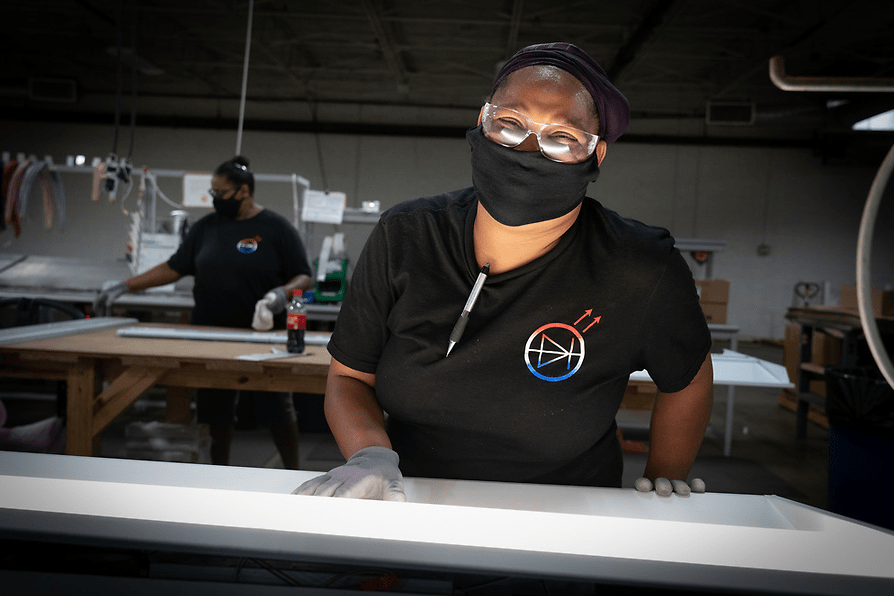
With manufacturers facing a skills gap that could result in 2.1 million unfilled jobs by 2030, retaining qualified and effective employees is critical. But how do manufacturing leaders keep great employees on staff? The Manufacturing Institute’s Center for Manufacturing Research and the American Psychological Association have some answers, collected in their recently published Manufacturing Engagement and Retention Study.
Why people stay: According to the study, the main reasons that employees remain at a company are enjoyment of the work (83%) and stability/job security (79%). Other contributors to satisfaction include the family friendliness of the employer and the way the job fits into their lifestyles outside of work.
- The next generation, however, has slightly different motives: “Although fewer survey respondents overall (42%) identified training and career opportunities as reasons for staying, around two-thirds of those under age 25 said these were motivating factors in their decision to remain with their current employer (69% and 65%, respectively).”
Feeling good: Employees who felt valued by their companies had significant more motivation and job satisfaction.
- Nearly all workers who said they felt valued by their employers (97%) described themselves as highly motivated and satisfied with their jobs. Nearly as many (96%) would recommend their company to others as a good place to work.
- Meanwhile, among employees who did not feel valued by their employers, those numbers dropped to 45% and 25%, respectively.
Fair treatment: Workers who felt that their employers treated them fairly were also less likely to be stressed out on a typical workday (at only 16%). But among workers who said they were treated unfairly, 68% felt stressed on a regular basis.
- Those who felt that they were treated fairly were also much less likely to say they intended to look for a new job within the next year—at just 2% versus 19% among those who felt they were treated unfairly.
Pandemic effects: The MI and APA conducted this study during the COVID-19 pandemic, which notably did not affect employees’ responses to a great degree. In fact, many felt more positive about their employers.
- A majority of employees (58%) said the pandemic and their company’s response to it had not changed their view, and more than one-third (37%) had a more positive view of the company, compared to just 5% who viewed their employer more negatively.
Find out more: Learn more about what motivates people to stay by reading the full study here.
A Second Chance in Manufacturing Pays Dividends
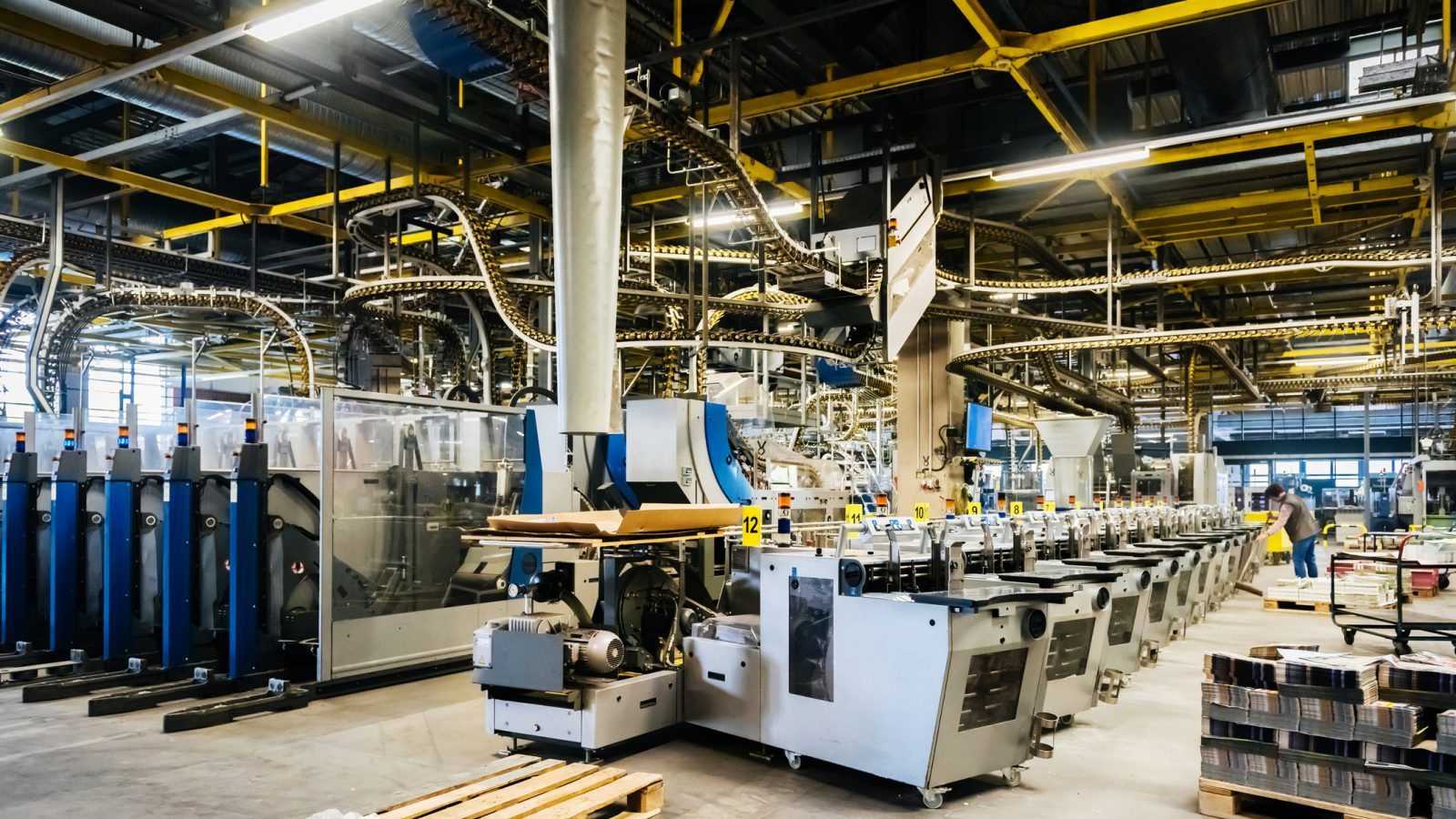
One of manufacturers’ top concerns is the insufficient number of skilled workers available to fill their open jobs. Yet right before us is an often-overlooked pool of millions of potentially strong employees: people with criminal records.
That’s why The Manufacturing Institute has partnered with Stand Together and the Charles Koch Institute to promote “second chance” hiring—to get these workers who need jobs into jobs that need them. Recently, the MI hosted its first webinar on the importance of this initiative and what manufacturers should know about it.
The data: One in three Americans has a criminal record, and yet this entire population is frequently discounted outright during employer job searches due to societal stigma and general misperceptions. During the webinar, the panelists shared some additional data:
- Of the approximately 19 million Americans with felony convictions on their records, some 1 million are incarcerated and some have aged out of the workforce, said Jeff Korzenik, author of “Untapped Talent: How Second Chance Hiring Works for Your Business and the Community” and chief investment strategist for Fifth Third Bank. “But millions are of working age, [and] virtually all of them are unable to participate to the fullest extent of their possibility, of their talents, because of barriers.”
Talent shortage: 814,000 manufacturing jobs were unfilled as of May, according to the Bureau of Labor Statistics.
- “Manufacturers continue to tell us that attracting and retaining workers remains one of their top challenges,” said MI Executive Director Carolyn Lee during the webinar.
- 2.1 million manufacturing jobs could go unfilled by the end of the decade if current trends continue, according to a recent MI and Deloitte study, and that “could mean the loss of up to $1 trillion in lost economic impact for the U.S.”
Worth the work: Employers who identify and support a strong candidate with a criminal record “get an employee who is on average more engaged and more loyal” than other workers, said Korzenik, who called this method of hiring the “second chance model.” This can lead to higher retention rates, saving an organization on turnover costs, he added.
- The model, which Korzenik developed, both identifies characteristics likely to lead to successful employment (strong character, soft and hard skills) and provides support processes (such as help with transportation to and from work) to help bridge gaps.
Living proof: Webinar panelist Cory Webb is a recent graduate of the Cuyahoga County, Ohio–based ACCESS to Manufacturing Careers, a program that trains both young people and people with criminal records for careers in manufacturing. He considers himself a testament to ACCESS’ success.
- “I started this program because I thought it would be a great opportunity for me to gain a career in manufacturing and machine operating,” said Webb, now an auxiliary operator for program participant Jergens Inc. The initiative “did a pretty good job as far as getting me prepared … for machine operating,” he said.
Learn more: The MI has released a host of resources for manufacturers interested in second chance hiring. You can find them here.
